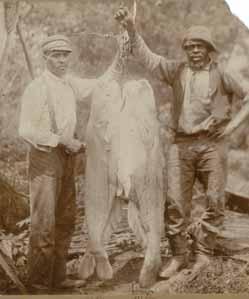
3 minute read
Accessing the Kaw
Accessing
the Kaw
By Kansas Riverkeeper Laura Calwell
»IN THE late 1800s Abe Burns and his friend Jake Washington used to ‘noodle’ for catfi sh just below Bowesock Dam, a stone dam constructed on the Kaw in 1874. After fastening a large hook to a board, they would tie the board to their arm and plunge underwater, searching holes below the dam where large cats liked to hide. When they found a big cat they gaff ed it with the hook and brought it to the surface. One day, Abe hooked on to a cat that was far too big for him to handle. Neither Abe nor the catfi sh surfaced until several days later when both he and the fi sh were found downstream — still hooked together.
Noodling is now illegal on the Kaw. But safe, responsible access to the Kaw is a public right. Public access and recreational use of the river is essential to its protection. Simply put, unless people get out in the water, they aren’t going to understand and appreciate what they have.
Nevertheless, for a long time, public boat ramps were so limited that boating on the Kaw was rare. Some fi shed from the banks of the river, but only those willing or able to maneuver their boats through the muddy, undeveloped access points — mostly under bridges — were able to get onto the river. Th e state recognizes the Kansas River as one of the state’s only three publicly navigable waterways,
Bill and Norman Cross catch & release a 65 pound Blue Catfish on the Kaw in April 2004.
The Kansas River runs over 171 miles of prairie from Junction City to Kansas City. Affectionately know as the Kaw, it is a shallow, sandy bottomed river with deep holes — habitat loved by Blue, Channel and Flathead Catfish. Catfish stay in the holes during the day and venture to the shallows to feed after dark. The Kansas state record Blue Catfish — 94 pound — was caught here.
Abe Burns (on the left) and Jake Washington in 1895 showing off their day’s catch of a 90 and a 110-pound Blue Catfish (before state records were documented).


along with the Arkansas and Missouri Rivers. Th eir tributaries are considered private property and are closed for recreational purposes. Although this is a violation of the Public Trust Doctrine, there has been little complaint. After 1951, when a Kansas River fl ood devastated Kansas City, reservoirs were constructed on the river’s tributaries to prevent the river from deluging nearby cities. Th e reservoirs, complete with fi shing, sailing, water-skiing, picnic areas and camping grounds, are in part the reason why the Kaw and its tributaries have been overlooked for their recreational potential.
Since 2003, Friends of the Kaw and Kansas Riverkeeper have been working to reopen public access to the river. Th at year, Mike Calwell, the kingfi sh of Kansas Riverkeeper’s access projects, received a grant from the Federation of Fly Fishers to work with a local community — St. George — to construct the fi rst access ramp along the Kansas River in 20 years. Since then, the Kansas Riverkeeper’s quest for open access has snowballed. With four access points completed and two more on the way, state and county governments and even communities along the Arkansas River are following our lead. Our dream of a public access ramp to the Kaw every 10 miles is almost a reality. Although there’s no more noodling, we believe that Abe and Jake would be very happy to see people back on the Kaw, fi shing. W










